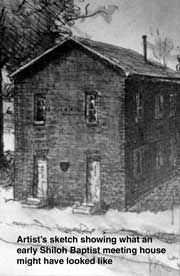 In the days and weeks following the signing of the Emancipation Proclamation, enslaved Africans of the Confederacy experience new hope for freedom. For some, the legal freedom granted them by the United States leads to renewed efforts to escape from their masters or stretch the boundaries of their autonomy while yet enslaved. In Fredericksburg, both scenarios are now taking place.
In the days and weeks following the signing of the Emancipation Proclamation, enslaved Africans of the Confederacy experience new hope for freedom. For some, the legal freedom granted them by the United States leads to renewed efforts to escape from their masters or stretch the boundaries of their autonomy while yet enslaved. In Fredericksburg, both scenarios are now taking place.
Last month’s Battle of Fredericksburg had not only severely damaged the white Fredericksburg Baptist Church, it had also rendered the African Shiloh Baptist Church–formerly an extension of the Fredericksburg Church, but independent since 1858–unusable. In the chaos immediately following the battle, many African Baptists–free and enslaved–fled north to the safety of Washington, D.C.
Then came the Emancipation Proclamation on January 1, at which time the Rev. George Rowe, the white minister who served as the “overseer” of the African congregation, resigned from his position. This month, the congregation appoints its first African pastor, freemen George Dixon, a member since 1854. Dixon, however, in the face of dangers to Africans in Fredericksburg, realizes that D.C. is a safer locale from which to base his ministry.
Now, many members of the African Baptist Church of Fredericksburg are living in the U.S. capital. Dixon for the remainder of the war spends most of his time in D.C., leading some 300 black Baptists from Fredericksburg in worship in a horse stable, and establishing a daughter congregation of Fredericksburg’s African Baptist Church, named the Shiloh Baptist Church of Washington, D.C.
Following the war, Dixon moves back to Fredericksburg, revives the city’s Shiloh congregation, and leads members in a drive to repair the church building. By the late 1860s, the Shiloh Baptist Church is a center of black life in the city.
Source: “History of Shiloh Baptist Church (Old Site), Fredericksburg, Virginia” (link)


